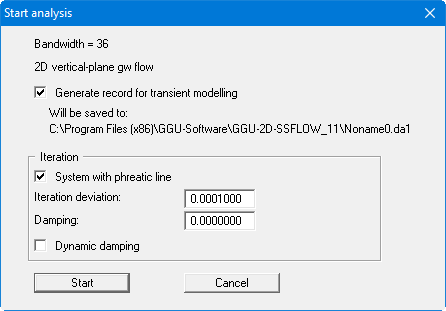GGU-2D-SSFLOW: Start analysis
Once you have selected the equation solver start the analysis using "OK". Depending on the type of system employed slightly variable (shown below for a vertical-plane system) dialog boxes appear (horizontal-plane, vertical-plane, axis-symmetrical):

The following check boxes and information can be provided in the dialog boxes:
Generate record for transient modelling
All data and results are saved in a file for possible subsequent transient groundwater analysis (additional module GGU-2D-TRANSIENT), contaminant transport analysis (additional module GGU-CONTAM-FE/-RW) or for subsequent graphical evaluation of the finite-element analysis. If this check box is activated the file name of the current file with the ".da1" extension is used by the program for the transient record. The file is always stored at the same level as the original steady-state file.Iteration deviation
If unsaturated zones are present within the system and computation of the phreatic line is required an iteration process will be necessary. The required iteration deviation for computation of the phreatic line is defined here. The program aborts the iteration if the deviation of the potentials at all nodes is below this limit value for two consecutive iterations. It avoids a negative iteration values in horizontal-plane systems.Damping
Oscillation around the actual solution can occur during computation of the phreatic line in complicated groundwater systems. This oscillation is damped by the damping factor. Values between 0.0 and 0.95 make the most sense. A value of 1.0 (complete damping) makes no sense and will therefore not be accepted by the program. Oscillations occur primarily when the curve of the kr(u) function is very steep (e.g. as for sand).
An additional button appears in the dialog box for vertical-plane or axis-symmetrical systems:
System with phreatic line
Specify whether a phreatic line should be computed for the system."Dynamic damping"
In extreme groundwater systems it may not be possible to reach a solution using normal damping. An analysis using dynamic damping may then be carried out. After every five iteration steps the damping value is increased by 0.05 up to a maximum of 0.99.
You will be informed on progress during the computation. After computation is complete you will see a message box showing the computation time. You can then move on to the "Evaluation" menu.
